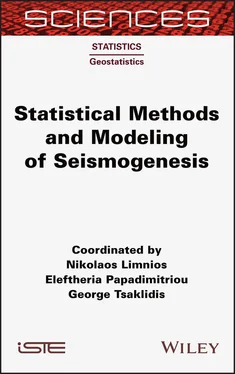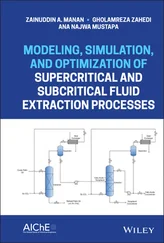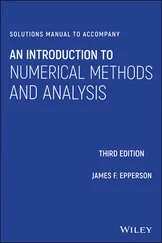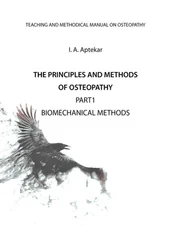Chapter 2, by Rodolfo Console and Roberto Carluccio, deals with earthquake simulator development and applications. Especially, this chapter deals with the concepts which earthquake simulators have been built upon and gives examples of the applications of such simulators to real fault systems, comparing them with observed seismicity. An example is given of the application of a simulator to the Nankai mega-thrust fault system, with particular emphasis to the study of the stress evolution on the fault surface during numerous repeating earthquake cycles.
Chapter 3, by Peter Shebalin and Sergey Baranov, deals with the statistical laws of post-seismic activity. In particular, this chapter discusses the ETAS model (a branching-type model with two empirical exponential laws), which is widely used in seismology for describing the clustering features of the earthquake process, and to what degree this model can explain the foreshock generation and the Båth’s law. The authors comment further on research results that have already been published.
Chapter 4, by Jiancang Zhuang, deals with the ETAS model, which is a branching-type model, widely used in seismology for describing the clustering features of the earthquake process. Based on the ETAS model, this chapter shows that the magnitude distribution of the largest descendant from a given event determines the foreshock probabilities and deduces the Båth’s law from the asymptotic form of this magnitude distribution, both of which are close to the values of actual seismicity data. The author also comments on some results from previous works.
Chapter 5, by Eugenio Lippiello, Giuseppe Petrillo, François Landes and Alberto Rosso, deals with the genesis of aftershocks in spring slider models. The main purpose of this chapter is to review the main assumptions and analytical steps proposed to explain the temporal behavior of aftershocks, in terms of both a time-dependent friction and afterslip dynamics. As a final step, we present how the two approaches can be combined. The two models are schematically presented in the figures of the chapter. The mathematical analogies between the two interpretations, and at the same time their very different physical implications, are stressed. The two descriptions are illustrated in a model with two blocks, with a different rheology interacting between each other.
Chapter 6, by Dimitris Karlis and Katerina Orfanogiannaki, deals with Markov regression models for time series of earthquake counts. Markov modems and HMMs offer a very elegant interpretation. Each state represents a different seismicity level, hence one may consider the transition probabilities as estimates of moving from one state to another, with the relevant increase/decrease of seismicity. In the Markov regression models, the transition probabilities change with time depending on additional variables. Different variables have a different effect on the transition probabilities. So, this property of the Markov regression model gives an insight into the mechanism behind state changes. This mechanism has physical interpretations, since the transition probabilities are directly linked, through regression, to physical quantities like earthquake magnitudes.
Chapter 7, by Georgios Michas and Filippos Vallianatos, deals with scaling properties, multifractality and a range of correlations in earthquake time series. The authors provide a mini-review on some of the collective properties of earthquake populations in the time domain, and based on these properties, we discuss whether earthquakes occur randomly in time or not. This topic is quite important for earthquake physics and ultimately for earthquake predictability. Their approach is based on the statistical physics of earthquakes that aims to elucidate the general physical mechanisms of seismogenesis, which produce the collective properties of earthquake populations that are empirically observed in nature. The earthquake occurrence is modeled by a point process in space and time, marked by the magnitude of the event and investigating the correlation properties of the waiting time (or interevent time) series between successive events.
Chapter 8, by Ourania Mangira, Eleftheria Papadimitriou and Georgios Vasiliadis, deals with self-correcting probabilistic models in seismology. The Stress Release Model (SRM) that belongs to this category considers elastic strain being accumulated due to slow tectonic loading, which is suddenly released when it overpasses the strength of a fault, during an earthquake. The real situation is more complicated, and for this reason, improved versions of the model have been developed, like the Linked Stress Release Model (LSRM), where interaction between different sub-areas is allowed by stress transfer, and the Independent Stress Release Model (ISRM), where the study area is divided into smaller independent parts without interaction. Results of the model applications in areas of Greece are presented, discussed and interpreted.
Chapter 9, by Polyzois Bountzis, Eleftheria Papadimitriou and George Tsaklidis, deals with Markovian arrival processes for earthquake clustering analysis. The temporal variations of the seismicity rate in certain areas are considered as the manifestation of the physical mechanism behind the seismicity behavior, which exhibits periods of excitation (clustering) and periods of relative quiescence (background seismicity). The method used for this purpose is based on the application of a bivariate stochastic point process, the Markovian arrival process (MAP), (N t, J t) t∈R+, whose intensity function, λ t, is modulated by the latent Markov process, J t. The hidden states of the latter correspond to distinct occurrence rates of the counting process, N t, which enables the modeling of changes in the seismicity rate.
Chapter 10, by Rodi Lykou and George Tsaklidis, deals with change point detection techniques on seismicity models. They present the detection techniques of the Poisson process, ETAS model and G–R law, and suggested approaches for seismicity rate changes, covering parametric and non-parametric tests and approaches lacking statistical hypothesis testing. Change detection in seismicity rates has been combined with the use of probabilistic forecasting models and simultaneous studies in the stress field and space domain. It constitutes a powerful tool for solving non-stationarity problems leading to promising results for the underlying mechanism of seismogenesis.
Chapter 11, by Vlad Stefan Barbu, Alex Karagrigoriou and Andreas Makrides, deals with semi-Markov processes for earthquake forecasts. In particular, the authors provide a different approach of earthquake forecasting using a special type of semi-Markov processes. The seismic zones are considered as the states of a semi-Markov process and a methodology is employed for estimating the transition probabilities of seismic events transit, from one specific seismic zone to another. The sojourn times in a certain state belong to a general class of distributions presenting the advantage that it is closed under minima and includes various continuous distributions like the exponential, Weibull, Pareto, Rayleigh and Erlang truncated exponential distribution.
The authors of this preface are grateful to all authors for their excellent collaboration.
December 2020
1
Kernel Density Estimation in Seismology
Stanisław LASOCKI
Institute of Geophysics, Polish Academy of Sciences, Warsaw, Poland
The basis of statistical seismology is the probabilistic distribution of earthquake parameters. Unfortunately, the models of probabilistic distributions of earthquake parameters are mostly unknown, and those which are thought to be known are often disproved by more thorough testing.
On the other hand, increasing quality and decreasing prices of seismic monitoring systems, increasing density of seismic networks and the development of event picking tools cause the current seismic catalogs to be large and rising. This situation opens up the area for model-free approaches to probabilistic estimation and statistical inferences, which to be accurate, require considerable sample sizes.
Читать дальше












